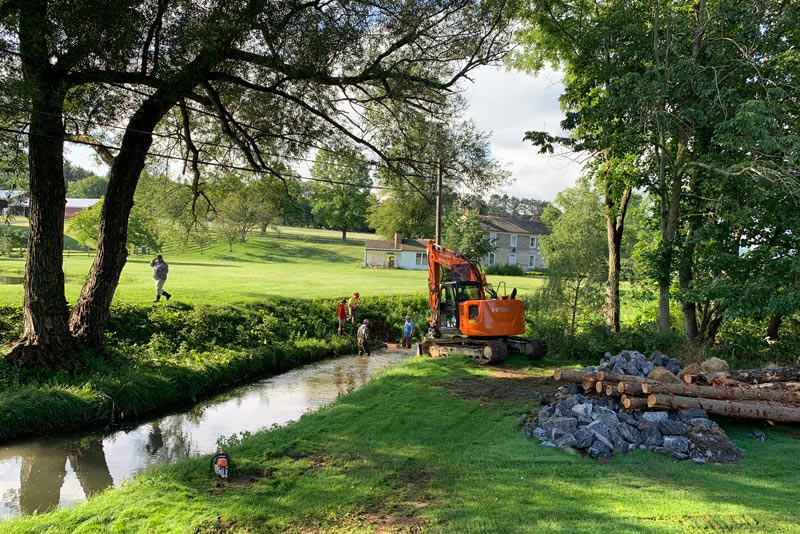
A (world-class trout) stream runs through it: Recent work at Centre Hills Country Club in State College, Pa., will eliminate 7.5 tons of sediment per year from Slab Cabin Run, which ultimately feeds into the Chesapeake Bay. The effort has also created choice habitat for the stream’s many brown trout. Photos courtesy of Steven Craig
Steven Craig readily admits that one of the reasons he accepted an offer to become director of grounds at Centre Hills Country Club in State College, Pa., was that it had a sweet little trout stream running through it. It didn’t take long for him to realize that stream had a few issues.
“I’m a big fly fisherman,” says Craig, a GCSAA Class A superintendent and 21-year association member. “To be quite honest, this all started because I was scoping for trout. This is a great stream, but I could tell the banks had eroded the past couple of years.”
What followed was an unusual, serendipitous, multi-agency effort that resulted in a stream-restoration project paid for almost entirely by Centre Hills CC members. And while the project was designed with long-term benefits in mind, Craig and the club’s members have enjoyed a nearly immediate payoff as well.
“The fishing’s fantastic,” Craig says. “It was great before. But it’s next-level now. It’s really impressive how many (trout) there are.”
Nearly 3,200 linear feet of the stream, Slab Cabin Run, meanders around and through Centre Hills CC’s 27 holes. It forms a tributary to Spring Creek, a traditional fly-fishing hot spot reported to have more trout per acre of water than any body east of the Mississippi River. That water, though, was threatened by erosion that was obvious to all who looked.
Phil Thomas, stream restoration specialist for Trout Unlimited, was among those who looked. He recalls years ago, when he was performing similar work for the Pennsylvania Fish and Boat Commission, seeing the eroded banks as he drove past the golf course.
“They were just vertical dirt banks, putting sediment and dirt in the water,” Thomas says. “There was this huge effort to get the watershed restored, and there was the one property owner there, where all of these different agencies just couldn’t get anything done.”
That all changed in 2019, not long after Craig started at Centre Hills CC and a new co-worker of Thomas’ started at Trout Unlimited. The co-worker was a part-time musician, and he landed a gig at Centre Hills CC.
“It’s a funny story,” Thomas says. “I told him there’s this long-standing project a lot of people have wanted to do at the country club, a highly visible site with a lot of erosion going on, so I said, ‘Hey, while you’re there, why don’t you get permission to do the project?’ I thought I was giving the new guy an impossible task.”
His timing couldn’t have been better. The gig came just after a change in management and roughly coincided with Craig’s own observations about the erosion issues. Craig called it to the attention of the club’s green committee chair (who also was an avid fly fisherman), and they discussed with the club’s general manager ... who bumped into the Trout Unlimited musician. “It was just dumb luck on our part,” Thomas says.
Of course, the distance between permission and permitting can be measured in years and thousands of dollars. Thomas feared the latter could be the greatest sticking point, even with the potential for grants from Trout Unlimited and the ClearWater Conservancy, a large nonprofit tasked with conserving and restoring natural resources across central Pennsylvania.
“We were kind of spitballing how we were going to fund the project,” Thomas says. “A lot of the members at the country club are fly fishermen, and they said they thought they could raise all the money in-house. It was cool to see that buy-in from the members.”
Editor’s note: Protecting its golf course from an encroaching stream presented another Pennsylvania club with an opportunity to make a significant environmental splash. Go inside the initiative in Stream of conscience: Kennett Square Golf and Country Club.
The club started fundraising in late 2019. Aided by the efforts of then-president Damian Mochan and, especially, fly-fishing legend Joe Humphreys (an author and educator, subject of a decorated documentary, and a National Fly Fishing Hall of Famer), the membership came through this year. Thomas estimates the total bill approached six figures.
“Honestly, I didn’t think it was going to happen,” Craig says. “All of a sudden, it was done. One thing I know, Centre Hills members like their club. They’re willing to take care of what needs to be taken care of, and they’ll put the money in it to do it.”

Restoration work underway at Centre Hills Country Club on Aug. 2, 2021.

Centre Hills Country Club superintendent Steven Craig (second from left) and crew members Tanner Helms, Todd Robison and Nick Capparelle.
Phase One — carried out the first week of August by Craig and four members of his staff, a construction company, and Thomas and another worker from Trout Unlimited — increased fish habitat and shored up the stream bank. Construction materials included more than 200 8- to 10-inch-diameter hemlock logs (from 10 to 20 feet long), 4-foot-diameter root balls, 500-some 5⁄8-inch rebar pins, and 240 tons of 12- to 18-inch-diameter stones. The 45 in-stream structures will eliminate an estimated 7.5 tons of sediment each year.
Phase Two is scheduled to commence this fall, when the ClearWater Conservancy, through grants and volunteer work, will plant native shrubs and trees along the bank to create a riparian buffer to improve water quality and provide shade to protect the stream.
Ultimately, Thomas thinks the stream can serve as more than a nice honey hole for Centre Hills CC members.
“I think it could be a really cool showcase project,” he says, “for all golf courses that have streams running through them.”
Andrew Hartsock is GCM’s managing editor.